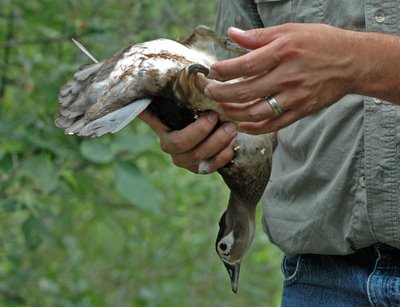Wood Ducks 05/06
2006 Wood Duck season
This blogg contains a brief description of what you might encounter in your boxes and some do's and don't during the nesting season. Hope you find this helpful. Feel free to comment, i will reply as time permits.

Above, a picture of a previously banded hen Wood Duck. The number was recorded in box data chart then given to CWA for further tracking at the end of the 06 spring season.
Note: A live capture and recording of band number has far greater value than a bird that has been shot or found dead. This allows the band data to possibly be recorded again and again. This is the only way to confirm with 100% certainty that the same hen uses the same box. For further information on how to band birds in your project, contact your local CWA organization about setting up a day to band your hens. It is a great experience!
 To the right, is one of five hens we banded during the '06 spring. The process of capture / banding took about 7 minutes due to the expertise of our CWA wildlife biologist being well prepared.
To the right, is one of five hens we banded during the '06 spring. The process of capture / banding took about 7 minutes due to the expertise of our CWA wildlife biologist being well prepared.
Note; It is strongly suggested not to disturb a hen "capture her" within the first two weeks after the first egg "s" are layed as this could lead to nest abandonment. This hen went on to lay 16 eggs,12 of which hatched.
Below are some examples of what you might find in your boxes and what we find is not always what you expect but this adds to the fun of checking boxes on a regular bases.
Below, a Barn Owl with 5 young raptors. This nest was left alone until the bird was large enough to take flight. I say "bird" because these babies tend to eat each other as their food demand increases. Normally only one survives.

Below, a Starling nest, called a coil which are the most common species found in our boxes. Just removing the nest with or with out eggs isn't good enough for these guys as they are a very persistent, they will come back and rebuild / lay again. Unfortunately you have to remove several nest before the Male starling moves to another site.

Below we have a typical Wood Duck nest, but to the average on looker they most likely see nothing,,, but lift the down blanket and you'll find what your looking for. The key is noticing the gray down that covers the top of the eggs. Also, notice that there are no sticks, primary feathers or other nesting materials that make up this nest, only down.

Below are the 7 eggs that were under the blanket above. The eggs should be warm to the touch, but if eggs are cold, do not remove them, cover them back up and check the nest 7 and 14 days later before removing as a discarded nest. I have had many, many nest that appear as abandoned nests only to find that the hen returns to hatch. A normal clutch will have between 8 and 14 eggs and the average is 11.

Below is a dump box 22 eggs here! This typically means one of two things. 1 - multiple first year hens using the same box, or 2 - that you need to build more boxes for your project. This nest was made up of several young hens, at least two possible three.
Below are some different types of eggs we find in our boxes. Row one are Wood Duck eggs, row two are Barn Owl eggs and row three are Starlings. You might think you'd have trouble telling the difference between and Wood Duck and Owl but its very easy. Owls are slobs, they defecate everywhere and sometimes have dead mice laying around bottom of box. Wood Duck are very, very clean, you should only find the down blanket.
One more thing, sorry no photos for this one... When checking boxes, if i find a new hen sitting, meaning one that has only been sitting for about 14 days or less. I will not flush her or try to get an egg count. Instead WAIT for 14days before flushing to get an egg count or she might abandon the nest. After 14 days she's very committed to the nest and most likely return to the nest. Also if you do flush her make sure to cover her eggs up with the down blank.
Our projects final numbers for the '06 season;
- 180 eggs
- 135 hatches
- 16 nests
Key activities:
1 - Make certain boxes tops will not take on water, a little moisture is ok, actually its needed but hen will do this. Our tops extend 1 1/2 inches beyond the out side of the box dimensions.
2 - Start checking your boxes two weeks before your season begins. If possible check them weekly For us, in the Suisun, CA marsh that was April through June for the '06 year.
3 - Remove other species eggs as soon as you find them, unless of course that species is acceptable to your program. If you hatch other species of any kind you are most likely not checking your boxes enough. You should never have to dispose of any hatched birds. My rule of thumb, if they get out of the egg that species gets the box!
4 - Bring a small camera to document what you see
2006 Firsts:
Saw my first hatched nest with babies in it
Banded Five hens with CWA biologist
Dump box with 22 eggs
2 boxes had double clutches "nest"


